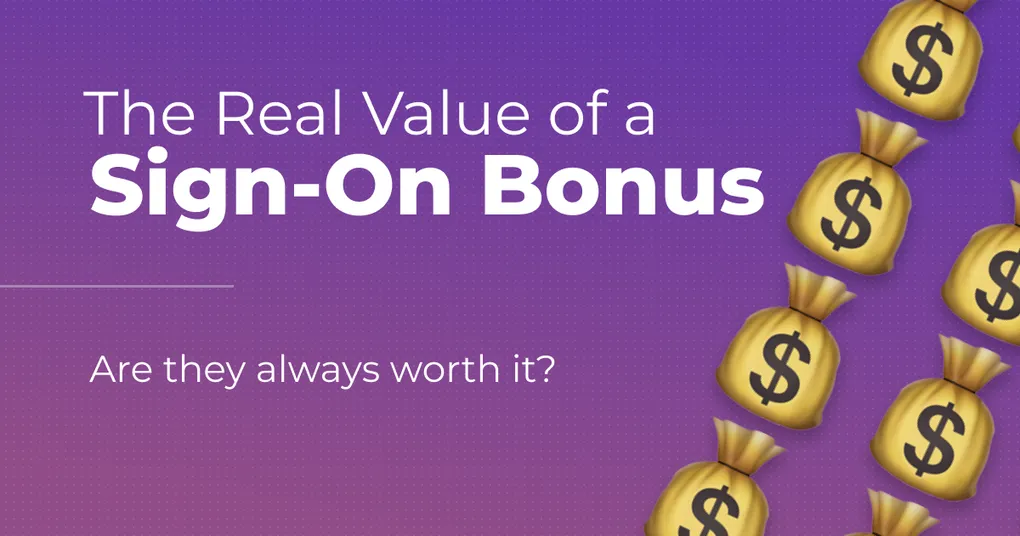
The Real Value of a Sign-On Bonus (and What to Watch Out For)
Imagine this: you’ve just received a job offer. The salary looks solid, the benefits check out, and then you notice a shiny perk; a $10,000 sign-on bonus. Sounds amazing, right?
Before you mentally spend that money, it’s important to understand how sign-on bonuses work, what strings might be attached, and whether they actually make your offer better in the long run.
In this guide, we’ll cover:
- What a sign-on bonus really is
- Common repayment clauses you need to know
- How to compare a bonus to other benefits
- When it makes sense to take one
- How to negotiate for a sign-on bonus
For more context on the bigger picture, check out our guide on Understanding Total Compensation in a Job Offer.
What Is a Sign-On Bonus?
A sign-on bonus is a lump sum of money offered to new employees when they join a company. It’s usually paid within the first few weeks or months of employment.
Why companies offer them:
- To attract talent quickly in competitive industries
- To make up for lost perks (like forfeited bonuses at your old job)
- To sweeten an offer when they can’t increase base salary
Unlike salary or equity, a sign-on bonus is one-time cash. Once it’s paid, it doesn’t repeat year after year.
The Strings Attached: Repayment Clauses
Here’s the catch, many sign-on bonuses come with repayment obligations if you leave the company too soon.
Common repayment structures:
- 12-month requirement: If you leave before a year, you must repay the full bonus.
- Pro-rated repayment: If you leave at 6 months, you pay back 50%.
- Clawback for cause: If you’re terminated for misconduct, the company may require repayment.
Always read the fine print. Repayment clauses can turn that “free” $10,000 into a serious liability if you change jobs too quickly.
Comparing a Sign-On Bonus to Other Benefits
On paper, a sign-on bonus looks huge. But when comparing offers, you need to see if the bonus outweighs benefits that repeat annually.
Example:
- Offer A: $100,000 salary, $10,000 sign-on bonus, average benefits.
- Offer B: $100,000 salary, no bonus, but better health insurance (worth $5,000 more per year).
Year 1: Offer A looks better ($110,000 vs $105,900).
Year 2: Offer B pulls even, since the $5,000/year savings on health insurance now totals $10,000 — the same as the one-time bonus from Offer A.
Year 3: Offer B pulls ahead, delivering $15,000 in total savings on health insurance, which means you’re $5,000 ahead compared to Offer A.
That’s why bonuses should always be viewed in the context of total compensation. Tools like JobForager make it simple to see how all the pieces stack up.
When a Sign-On Bonus Makes Sense
There are times when a sign-on bonus is a great deal:
- You’re leaving money on the table at your old job (like an annual bonus or unvested equity).
- The bonus helps offset relocation costs.
- You need upfront cash for a life change (moving, starting fresh, debt repayment).
But if you expect to leave within a year or two, be cautious, the repayment clause could bite you.
When a Sign-On Bonus Isn’t Enough
Sometimes companies use bonuses as a distraction when the core offer isn’t competitive.
Red flags to watch for:
- Salary below market rates
- Weak or expensive health insurance
- Little or no retirement contributions
- Equity package that’s small or high-risk
In those cases, it’s better to focus on improving the recurring parts of your package. Our guide on How to Negotiate a Job Offer has strategies you can use to push for better long-term compensation.
How to Negotiate a Sign-On Bonus
If you like the offer but think there’s room to sweeten the deal, a sign-on bonus can be a great ask.
Tips for negotiating:
- Bring up timing issues: “I’ll be leaving an annual bonus behind at my current company, is there flexibility to offset that?”
- Frame it as a bridge: “If salary is set, would you consider a sign-on bonus to help close the gap?”
- Be specific: Ask for a number tied to your situation (lost bonus, relocation, etc.).
Companies often prefer one-time bonuses over recurring salary increases, since it’s a smaller long-term commitment.
Sign-On Bonus vs Raise
Would you rather have a $10,000 bonus or a $5,000 salary increase?
- Bonus: one-time, taxable cash, gone after Year 1.
- Raise: repeats every year, compounds into future raises and retirement contributions.
After two years, the raise is already more valuable. Over five years, it’s dramatically better. For more on building recurring income, see How to Get a Raise.
Sign-On Bonuses in Different Industries
- Tech & Finance: Large bonuses common, especially at senior levels.
- Healthcare: Often used to attract doctors or nurses to hard-to-staff regions.
- Startups: Less common, though some offer smaller bonuses to compete with big firms.
In each case, always check how the bonus compares to industry standards for base pay and equity.
Final Thoughts
A sign-on bonus can be helpful, but it’s only a short-term benefit. It’s a short-term sweetener, not a substitute for strong salary, equity, and benefits.
Before saying yes:
- Read repayment clauses carefully.
- Compare the value against recurring benefits.
- Think about how long you’ll realistically stay.
Most importantly, remember that the bonus is only one piece of the puzzle. For a true apples-to-apples comparison, use JobForager to see how sign-on bonuses, salary, PTO, insurance, and equity all add up.
For more on evaluating offers, check out our guides Understanding Total Compensation in a Job Offer and How to Negotiate a Job Offer
Happy job hunting,
The JobForager Team